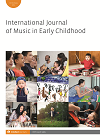
Full text loading...
 , Susan Young2
, Susan Young2
Infants and children in their earliest years (6 months to 3 years) are highly motivated to act on objects to produce sounds and to explore the possibilities of sound production. Yet educational practice and music education research rarely concentrate on very young children’s abilities to produce sounds with objects or with age-appropriate musical instruments. There is, however, a small corpus of studies that have explored sound production among the under-3s and have suggested the importance of this activity in early musical development. In this article we first introduce and discuss this corpus of studies. In light of the theories of musical gesture and sound production emerging from these studies, we then propose a complementary music education perspective for young children under 3 years of age which is focused on sound production with objects.

Article metrics loading...

Full text loading...
References


Publication Date:
https://doi.org/10.1386/ijmec_00020_1 Published content will be available immediately after check-out or when it is released in case of a pre-order. Please make sure to be logged in to see all available purchase options.